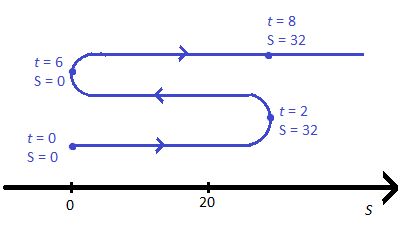 |
|---|
| PAGE: 173 | SET: Exercises | PROBLEM: 1 |

The function is  .
.
(a)
Find the velocity at time  :
:
The motion of the particle is  , where
, where  is in seconds and
is in seconds and  is measured in feet.
is measured in feet.
Velocity function is derivative of the position function and is defined as  .
.
 .
.

Velocity at time  is
is  .
.
(b)
Find the velocity after  sec :
sec :
Velocity function is  .
.
Substitute  in above expression.
in above expression.

Velocity after  seconds is
seconds is  ft/sec.
ft/sec.
(c)
Find the time when particle is at rest.
Velocity function is  .
.
When the particle is at rest, the initial velocity is zero.
 .
.

 and
and  .
.
The particle is at rest when  sec and
sec and  sec.
sec.
(d)
Find the time when the particle move in positive direction.
Velocity function is  .
.
When the particle is at rest, the initial velocity should be greater than zero.
 .
.

The above inequality is true, when both factors are positive or both factors are negative.
If both factors are positive, then  and
and  .
.
It is concluded that  .
.
If both factors are negative, then  and
and  .
.
It is concluded that  .
.
The particle moves in positive direction when  and
and  .
.
(e)
Find the distance traveled by particle in  sec.
sec.
The time intervals are  ,
,  and
and  from (d).
from (d).
Find the distance traveled by the particle in the interval  .
.
The function is  .
.

 .
.
 .
.
Find the distance traveled by the particle in the interval  .
.


 .
.
Find the distance traveled by the particle in the interval  .
.

 .
.
 .
.
Total distance is  ft.
ft.
(f)
The schematic diagram of motion of the particle is

(g)
Find the acceleration at time  and after
and after  sec.
sec.
Acceleration is derivative of the velocity function.
Velocity function is  .
.

The acceleration at time  is
is 
Acceleration after  sec :
sec :
Substitute  in the acceleration.
in the acceleration.

Acceleration after  sec is
sec is  .
.
(h)
Graph :
Graph the position, velocity and acceleration functions for  .
.
.gif) .
.
(i)
The particle speeds up when the velocity is positive and increasing.
Thus, from the graph it happens in the interval  .
.
The particle also speeds up when the velocity is negative and decreasing.
Thus, from the graph it happens in the interval  .
.
The particle slows down when the velocity and acceleration have opposite signs.
Thus, from the graph it happens in the interval  or
or  .
.
(a) Velocity at time  is
is  .
.
(b) Velocity after  seconds is
seconds is  ft/sec.
ft/sec.
(c) The particle is at rest when  sec and
sec and  sec.
sec.
(d) The particle moves in positive direction when  and
and  .
.
(e) Distance traveled in first  sec is
sec is  ft.
ft.
(f) The schematic diagram of motion of the particle is

(g) Acceleration after  sec is
sec is  .
.
(h)
.gif)
(i)
When the particle speeds up in the interval  or
or  .
.
When the particle slows down in the interval  or
or  .
.

|
"I want to tell you that our students did well on the math exam and showed a marked improvement that, in my estimation, reflected the professional development the faculty received from you. THANK YOU!!!" June Barnett |
|
"Your site is amazing! It helped me get through Algebra." Charles |
|
"My daughter uses it to supplement her Algebra 1 school work. She finds it very helpful." Dan Pease |











